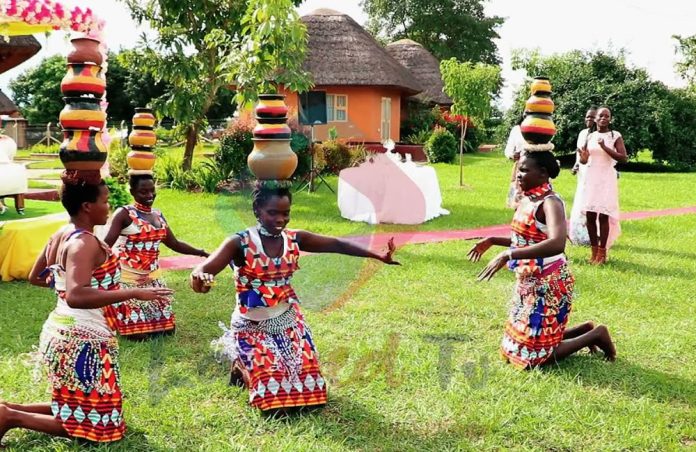A dance with pots. Herein the ladies rave with several pots lined up vertically atop their heads. But that’s a basic description; there is more. Hands out, waist in, and neck held high, this is a dance of pride!
It is a showcase of skill and then some more pride. The long yet elegant strides, waist jiggle here and there, the giggle, it is quite something, this dance. The Acholi pot dance is one to watch.
See, it almost never starts right away. First comes the tease, as if a reminder to the audience that the ladies come from the land of Acholi. A beautiful Ugandan people based in the Northern part of the country. It’s a dive into almost all the Acholi dances as if to tell of the many skills abreast. But experts will argue this is because it has evolved.
The Gist
In fact, whilst speaking to a local daily, Stephen Rwangyenzi, the founder and executive director of Ntinda-based, Ndere Troupe, says that there are areas where they have made deliberate changes and simple additions to attract the audience to the dance. “The carrying of pots in the Laraka-raka dance and telling of stories around the dances was my addition to make the dances attractive,” he begins. “But I endeavor to perform the first part authentically and then make the additions later.”
It should just be a tune and the straight into the pot dance, but a lot has changed. In most cases, it begins with the Laraka-raka dance, a different dance, a more vigorous one. Also called Lamokowang, this dance’s signature call comes from the cries of a wire-stricken calabash. But this for another day; back to the dance of pots. Quickly yet gently, the ladies will withdraw to the back as the men make way and fade off into just providing the sound for this showcase. Soon the elegant damsels each return with a pot in hand. First is one, just the one. Then they dance, boast even, as if to say, “…look, I can dance and carry a pot at the same time.”
But they dance, they making some sort of line and occasionally break away to explore the different angles of the stage. As if to get the audience wondering what is next, they giggle and sometimes share a laugh among themselves. They break into twos or threes and tease the audience. Look at their pots and smile, then gyrate their waists a little bit and walk around some more. This is a warm-up!
At this point, first-time watchers are wondering what the pot in hand is for. They slowly bring it to the center, around their abdomen, and shake their waists. It’s a tease, they know it’s working, so they smile. Then slowly, smiles getting brighter by the second, the pots are uniformly put on each girl’s head. That’s the moment it makes sense. The men have all faded at this point and the womenfolk, looking like gazelles, begin to boast. Woo them; dance to their tunes, literally!
The Tease
The Acholi girl mostly boasts glowing skin and long legs. She is the master of her waist. The art of waist wiggling, therefore, comes easy. So even as the pot goes to the head, she must find a balance, a way to still wiggle and keep the pot atop. Note, however, as the pot goes on the head, the true dancer is one who also makes subtle jumps, yet still manages to keep the pot in place without holding it.
Then one by one they start running off the stage, and back to where more pots await. They must return with two pots each and this times move even firster as the instruments get louder. Looking like queens, they keep going, testing and pushing themselves further. One-pot will soon become two and three and four and five and more, all piled atop each other.
Get this: it is done while musically walking around with their newfound ‘crowns’. Sometimes the music goes lower, slower maybe and then firster and this girl leave the crowd fascinated and also curious as how one can walk around carrying not one but several pots.
At this point, the sound of the calabash has been replaced with a more melodic instrument, sometimes the Adungu from West Nile is borrowed. Also called the African guitar, the Adungu provides for a melodic atmosphere, more relaxed and elegant. A flute could be used sometimes! See, everything must feel Ugandan once the Acholi take to the pot dance. And the girl will walk, sway, suave, boast to the tune of this music, all the while carrying their pots.
The more skilled the girl, the more pots she carries, and the more vigorously she dances. Quickly she can be seen returning to have the men put another pot on the already long crown of pots. At one point, their helpers have to get on higher ground, or a table to add a pot on their heads. But these girls love the tease. They like to keep the audience wondering how many more they can take.
The tall girls look even taller and the shorter girls find that they must carry more pots if they are going to outcompete the other girls. Also, know what to do when it looks like a pot my drop. In fact, it is not rare that you see once staggering about trying to keep the pots in order. “When it is about to fall, I reduce the speed and then pretend like I am spreading my hands out,” Clara Achen, a folk dancer with the Gulu-based Dhako dance group says. “Then I breathe slowly, try not to mover my head until it is stable.”
Clara maintains that it takes time to learn this skill, and for the naturally talented, it could take them just a month to get very good. “But other people, especially the ones who have never carried anything on their head can take even years,” she adds as a matter of fact. “So they carry maybe one or two while others carry even 10.”
The Story Here
Note though, that though widely danced by the Acholi, researchers argue that the pot dance originated from Teso. They also argue that since it is popular among the Langi, a tribe sandwiched between the Acholi and Iteso, this makes sense. Asked if this was true, Gabriel Komagum, a traditional dance trainer and student of Music Dance and Drama himself, says he doubts that but then thinks anything is possible.
“I don’t think so, but since the Iteso is just about a little over 100kms away from the north, anything is possible,” he says. He however goes on to explain how the dance found its baring among the Acholi people, a tribe from which he hails. “First of all, this is a courtship dance,” he states. “As they danced, the men would look for the young lady who could carry the most pots on her head.”
One thing is for sure, this dance is a symbol of culture; a showcase of love, skill and pride. In fact, the choice of the pot; a two-mouthed pot, has been known to be used for other rituals like, the welcoming of twins into a family. Many call it the ballet of Uganda. And indeed, like ballet, it exudes elegance and balance!










